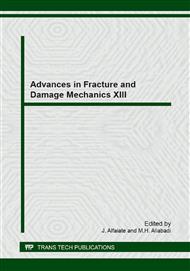[1]
Böhm, H.J., Han, W., Eckschlager, A., 2004. Multi-inclusion unit cell studies of reinforcement stresses and particle failure in discontinuously reinforced ductile matrix composites. CMES: Computer Modeling in Engineering Science 5, 5–20.
Google Scholar
[2]
Eshelby, J.D., 1957. The Determination of the Elastic Field of an Ellipsoidal Inclusion, and Related Problems. Proceedings of the Royal Society A: Mathematical, Physical and Engineering Sciences 241, 376–396.
DOI: 10.1098/rspa.1957.0133
Google Scholar
[3]
Mori, T., Tanaka, K., 1973. Average stress in matrix and average elastic energy of materials with misfitting inclusions. Acta Metallurgica 21, 571–574.
DOI: 10.1016/0001-6160(73)90064-3
Google Scholar
[4]
Kachanov, M., Tsukrov, I., Shafiro, B., 1994. Effective moduli of solids with cavities of various shapes. Applied Mechanics Reviews 47, S151.
DOI: 10.1115/1.3122810
Google Scholar
[5]
Drach, B., Tsukrov, I., Gross, T., Dietrich, S., Weidenmann, K., Piat, R., Böhlke, T., 2011. Numerical modeling of carbon/carbon composites with nanotextured matrix and 3D pores of irregular shapes. International Journal of Solids and Structures 48, 2447–2457.
DOI: 10.1016/j.ijsolstr.2011.04.021
Google Scholar
[6]
Widom, B., 1966. Random Sequential Addition of Hard Spheres to a Volume. The Journal of Chemical Physics 44, 3888.
DOI: 10.1063/1.1726548
Google Scholar
[7]
Lind, P.G., 2009. Sequential random packings of spheres and ellipsoids. In: AIP Conference Proceedings, Vol. 219, AIP, p.219–222.
DOI: 10.1063/1.3179897
Google Scholar
[8]
Donev, A., Cisse, I., Sachs, D., Variano, E. a, Stillinger, F.H., Connelly, R., Torquato, S., Chaikin, P.M., 2004. Improving the density of jammed disordered packings using ellipsoids. Science (New York, N.Y.) 303, 990–3.
DOI: 10.1126/science.1093010
Google Scholar
[9]
Lubachevsky, B.D., Stillinger, F.H., Pinson, E.N., 1991. Disks vs. spheres: Contrasting properties of random packings. Journal of Statistical Physics 64, 501–524.
DOI: 10.1007/bf01048304
Google Scholar
[10]
Bertei, A., Chueh, C.-C., Pharoah, J.G., Nicolella, C., 2014. Modified collective rearrangement sphere-assembly algorithm for random packings of nonspherical particles: Towards engineering applications. Powder Technology 253, 311–324.
DOI: 10.1016/j.powtec.2013.11.034
Google Scholar
[11]
Byholm, T., Toivakka, M., Westerholm, J., 2009. Effective packing of 3-dimensional voxel-based arbitrarily shaped particles. Powder Technology 196, 139–146.
DOI: 10.1016/j.powtec.2009.07.013
Google Scholar
[12]
Khachiyan, L.G., 1996. Rounding of Polytopes in the Real Number Model of Computation. Mathematics of Operations Research 21, 307–320.
DOI: 10.1287/moor.21.2.307
Google Scholar
[13]
Altendorf, H., Jeulin, D., 2011. Random-walk-based stochastic modeling of three-dimensional fiber systems. Physical Review E 83, 041804.
DOI: 10.1103/physreve.83.041804
Google Scholar
[14]
Perram, J., Wertheim, M., 1985. Statistical mechanics of hard ellipsoids. I. Overlap algorithm and the contact function. Journal of Computational Physics 58, 409–416.
DOI: 10.1016/0021-9991(85)90171-8
Google Scholar
[15]
Drach, A., Drach,B., Tsukrov, I., 2014. Processing of Fiber Architecture Data for Finite Element Modeling of 3D Woven Composites. Advances in Engineering Software, 72, 18–27.
DOI: 10.1016/j.advengsoft.2013.06.006
Google Scholar


